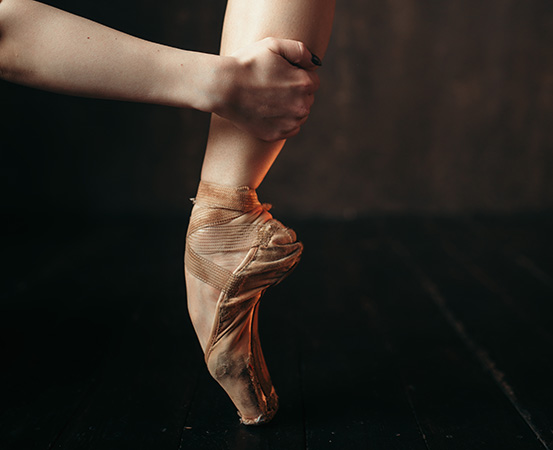
It is mesmerising to observe a dancer gyrating to the tone and timbre of the music. The rhythm of the foot movements, flexible twists and turns and dynamic music makes dancing a unique and uplifting visual experience. For the dancer, the experience is immersive as they live through every move. However, a performance, be it on stage or the dance floor, is the culmination of a tedious journey – hours spent learning and perfecting a style, along with all the sweat and strains that comes with any form of physical exertion. Pain and spasms caused by demanding rehearsals are pretty much a daily affair. Dancer’s cramp, they lovingly call it.
From back pain and knee pain to muscle cramps, performing strenuous dance moves can cause various kinds of aches and even spasms. This holds true for not just professional dancers but those indulging in dance fitness routines.
READ MORE :
Pain perception: Who feels it more, men or women?
How to get your eating posture right
ACL tears: When to go for surgery
Sciatica: How to not let it hit a nerve
Groin pain: Truth lies in the hip adductors
No pain, no gain: Dancing away the pain
Dancers have different ways to deal with it; ignoring the pain and following their passion being one of them. They tend to ignore the pain for the art’s sake playing out the ‘no pain, no gain’ trope. However, experts say otherwise.
Dhanashree Naik, a classical dancer from Pune, India, says a dancer should be conscious and understand their own body. It aids in conditioning the body and helps deal with the challenges better.
“Understanding one’s body is significant in learning and performing any dance form,” says Naik, an alumna of Kalakshetra Foundation, Chennai. “For instance, if a person’s thighs are weak, they should work on strengthening them. I was very new to the dance style when I started my Bharatanatyam journey from Kalakshetra a few years back. Understanding my body helped me a lot in tackling the challenges that I have faced when learning.”
The many aches of dancing
Back pain
The most common ails of dancers are knee and back pain. Incorrect technique is usually the main trigger.
“90% of the dancers face either knee pain or back pain,” says Leela Lakshmi, a classical dancer and teacher from Trichur, Kerala. “The incorrect delivery of jumps is a common source of back pain. People commonly land by exerting their entire body weight on their feet when jumping. In these situations, the spinal cord is under full pressure. This is one of the factors that contributes to back pain.”
Back pain is common among those practising western dance styles too.
“Hip hop dance has a lower risk of injury and pain than contemporary dance,” says Sachin Gopinath, hip hop and contemporary dance trainer, and founder director of Mystic Movers Dance Academy, Kochi, Kerala. “The most common injury in contemporary dancing is back pain. It is a style that features multiple lifts and stretches. Each formation, lift and stretch in contemporary dance exerts intense strain on the body.”
Knee pain
Some dancers may initially have minor knee problems. Learning and training dance forms can make it worse.
“Appropriate body balance must always be maintained when performing certain dance poses and movements,” says Lakshimi, an alumna of Kalakshetra Foundation, Chennai. “If not, when people transfer their weight to one leg, that could lead to knee pain or even major injuries.”
Heel pain and muscle cramps
Stamping on the floor while dancing can cause heel pain. A person who practises on cold, hard surfaces (granite or tiles) could frequently suffer heel pain.
Another problem is muscle cramps. Dancing after a long break results in muscle cramps.
“One’s body becomes stiff when they stop dancing for a long time,” says Lakshmi. “Engaging in constant dance moves after a break can result in muscle aches.”
How to negate pain and dance
Correctly executing dance techniques, postures and exercise routines can reduce and even eliminate discomfort or pain, say professionals. Whether it is classical or western style, doing proper warm-up and cool-down exercises is necessary for any dancer to prevent injuries and pain.
Cooling down is as crucial as warming up in classical dance. “Taking warm-up exercises [spring jumping, jumping jacks, sit-ups, stretches for legs, hands and neck] and cool down exercises [breathing exercises, yoga asanas, split, butterfly stretch] will help avoid muscle cramps,” says Lakshmi.
Gopinath adds, “People should warm up for at least 30 minutes before practice sessions and performances as a preventative measure. Warm-up exercises help lessen the intensity of the strain experienced when dancing in its entirety. An ideal warm-up routine consists of exercises for stretching the entire body, mobility strengthening and increasing stamina. It is also important to cool down, which entails slow and low-intensity exercises that help the body unwind.”
Body composition is another factor that could cause injuries. Some may have a lighter lower body compared to the upper body. They could have problems with knees because of their distinctive physical structure. “The only precaution is to get the required treatments if the pain is brought on by body structure or similar issues,” says Lakshmi.
Takeaways
- Back pain, knee pain and muscle cramps are common discomforts faced by dancers.
- Pain can be significantly decreased and even eliminated by performing dance techniques, postures and exercise routines (warm up and cool down) correctly.


















2 Responses
I have knee pain during yoga periods
Since I do it 3 months onwards
Recently I feel knee pain
Thank you for your query. However, we at Happiest Health do not give any medical consultation.